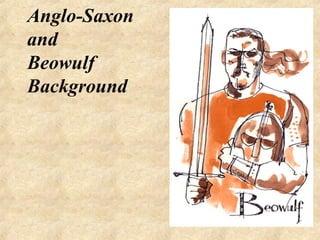
Beowulf Anglo Saxon and Beowulf Background
- 2. Background Information • 30,000 lines of Anglo-Saxon poetry survive today • 3, 182 (10%) of the lines are from Beowulf • Setting - Denmark and Sweden • Author - Unknown, probably a monk • Composed in the 7th or 8th century • Oldest surviving English poem
- 3. Anglo-Saxon Culture • Belief in fate (Wyrd) • Accumulated treasures amount to success • Fame and fortune zealously sought after • Loyalty to one’s leader crucial • Importance of pagan, Germanic, and Christian ideals to people whose lives were often hard and uncertain
- 4. Anglo-Saxon Culture • Fierce, hardy life of warrior and seamen • Strength, courage, leadership abilities appreciated • Boisterous yet elaborately ritualized customs of the mead-hall • Expected the hero to boast
- 5. Anglo-Saxon Ideals Codes of Conduct • Good defeats evil • Wergild--restitution for murder or expect revenge from victim’s relatives • Boasts must be backed with actions. • Fate is in control • Fair fights are the only honorable fights
- 6. Epic Poem • Long narrative poem that recounts the adventures of a hero. • Elevated language • Does not sermonize • Invokes a muse • Begins in media res • Mysterious origin, super powers, vulnerability, rite of passage
- 7. The Epic Hero • Actions consist of responses to catastrophic situations in which the supernatural often intervenes. • Code of conduct forces him to challenge any threat to society • Destiny discovered through a series of episodes punctuated by violent incidents interspersed with idyllic descriptions.
- 8. Elements of Anglo-Saxon Poetry • Chant-like effect of the four-beat line • Alliteration (“Then the grim man in green gathers his strength”) • Caesura-pause or break in a line of poetry (“Oft to the wanderer weary of exile”) • Kenning-metaphorical phrase used instead of a name (“battle-blade” and “ring-giver”) • Epithet-description name to characterize something (“keen-edge sword”) • Hyperbole-exaggeration
- 9. Title of Epic Poem • Anglo-Saxon word Beo means “bright” or “noble” • Anglo-Saxon word wulf means “wolf” • Beowulf means bright or noble wolf • Other sources say Beo means “bear”
- 10. How we date Beowulf Some Important Dates: 521 A.D. – death of Hygelac, who is mentioned in the poem 680 A.D. – appearance of alliterative verse 835 A.D. – the Danish started raiding other areas; after this, few poets would consider them heroes SO: This version was likely composed between 680 and 835, though it may be set earlier
- 11. The Poetry in Beowulf 1. Alliterative verse a. Repetition of initial sounds of words (occurs in every line) b. Generally, four feet/beats per line c. A caesura, or pause, between beats two and four d. No rhyme
- 12. The Poetry in Beowulf 2. Kennings a. Compound metaphor (usually two words) b. Most were probably used over and over For instance: hronade literally means “whale- road,” but can be translated as “sea”
- 13. More Kennings Other kennings from Beowulf: “bone-house” = body “gold-friend of men” = generous prince “ring-giver” = lord “flashing light” = sword
- 14. Setting: Beowulf’s time and place Europe today Insert: Time of Beowulf
- 15. Some terms you’ll want to know scop A bard or story-teller. The scop was responsible for praising deeds of past heroes, for recording history, and for providing entertainment
- 16. Terms: Thane and Mead- Hall thane A warrior mead-hall The large hall where the lord and his warriors slept, ate, held ceremonies, etc.
- 17. Term: Wyrd wyrd Fate. This idea crops up a lot in the poem, while at the same time there are Christian references to God’s will.
- 18. Main Characters
- 19. Beowulf • Epic hero • Geat (from southern Sweden) • Nephew of Higlac (King at story’s start) • Sails to Denmark to help Hrothgar
- 20. Hrothgar • Danish king • Builds Herot (banquet hall) for men • Tormented by Grendel for 12 years • Loses many men to Grendel • Joyless before Beowulf’s arrival
- 21. Grendel • Referred to as demon and fiend • Haunts the moors (swampy land) • Descendant of Cain • Feasts on 30 men the night of 1st attack
- 22. Grendel’s Mother • Referred to as she- wolf • Lives under a lake • Challenges Hrothgar when she kills one of his best men
- 23. Fire Dragon • Lives in Beowulf’s kingdom • Wakes up when thief steals cup • Guards countless treasures
- 24. Works Cited • Intro to Beowulf
